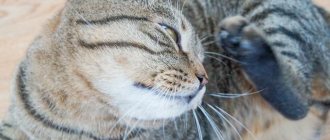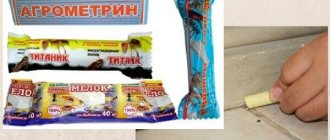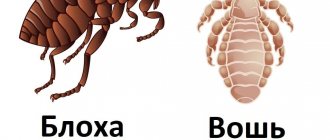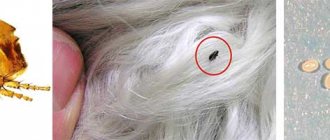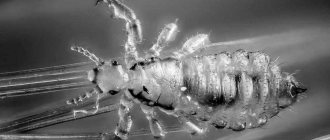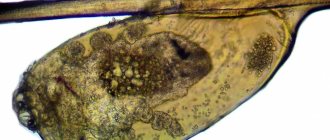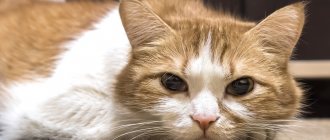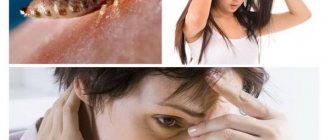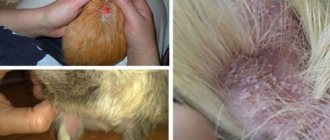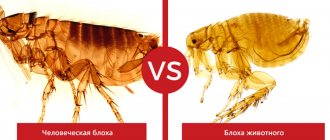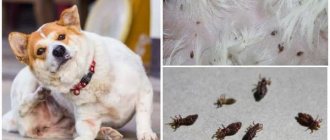Pets have a variety of parasites, both external and internal. But if fleas are on everyone's lips, then lice are considered an exclusively human problem. Lice, or pediculosis, occurs in kindergartens and summer camps. A child can catch an infection by using, for example, someone else’s comb.
However, both cats and dogs can also be parasitized by these annoying insects. The good news is that lice are strictly species-specific parasites. This means that cat louse cannot live on a person or dog, and human louse is not dangerous for pets.
Lice in dogs
“Lice” are popularly called any small insects that cheerfully rustle in a dog’s fur. However, only a veterinary dermatologist or a very experienced dog breeder can distinguish a true dog louse from lice-eaters. These are completely different insects.
Sucking louse
(true louse) bites through the skin to feed on the host's blood.
Biting louse
(hair eater) feeds on desquamated particles of the epidermis, causing more severe skin irritation. It parasitizes on the head, neck and tail, around natural openings. Infestation with lice eaters is called trichodectosis, and infestation with lice is called siphunculatosis.
Infection usually occurs through close contact between animals, but is also possible through contact with contaminated objects, bedding, and surfaces. Lice most often occur in puppies.
Symptoms:
- intense itching;
- the appearance of crusty papules on the skin;
- hair loss;
- peeling of the skin, signs of dry seborrhea;
- tangling of fur and matting in tangles in places where lice hide.
How can you tell if your pet cat or dog is infested with lice?
First of all, it is important to carefully examine the animal. Lice are located closer to the epithelium and will not quickly disappear from view, unlike fleas. In addition, attention should be paid to parasite eggs. Nits are firmly attached to the fur and are quite difficult to remove even by picking them off with your fingernails. The following symptoms should be signs of concern:
- Severe itching in a cat or dog;
- Hair loss;
- Dermatitis;
- The coat becomes excessively dry.
Mainly, lice like to live at the base of the tail, on the neck or head of a pet, so attention should be paid to these places. Parasites multiply at lightning speed and if treatment is not started in time, your pet will begin to go bald and will have to undergo a complete haircut. This factor is especially negative for breeds with long and thick coats.
If the animal begins to behave extremely suspiciously, then take the time to conduct a full examination, which will take literally a few minutes. You can identify lice almost immediately if you carefully study the information about lice. Look out for insect excrement that looks like black dots. The main alarm signal will be the appearance of a large number of nits. In such situations, lice have already become well established on your pet and continue to multiply.
Diagnostics
Signs of lice in animals resemble allergic dermatitis caused by fleas. Diagnosis is complicated by the fact that a pet can have both fleas and lice at the same time. Sometimes infection is accompanied only by slight peeling. Lice can be identified by careful examination of the skin and fur.
Lice appear as dark, oval-shaped objects. Lice eaters move quickly and are very difficult to catch. Body length – 1–1.5 mm. The sucking louse is less mobile and larger – up to 2 mm. You can see nits - lice eggs attached to the fur.
Do human lice live on animals, particularly domestic ones?
Lice are often found on mammals, but, as a rule, each animal has its own special type of parasite, adapted to its blood and hair. This also applies to people - human lice cannot be transmitted to a pet, only for the reason that the insect will not find a way to move around the body and receive nutrition.
The danger of lice and lice for cats and dogs
Lice and lice-eaters themselves are not very dangerous, but the consequences of their parasitism can be very serious.
- Cucumber tapeworm infection
. Like fleas, cat and dog lice eaters are intermediate hosts of tapeworms. An animal becomes ill by swallowing an infected insect while biting it. Young children who are in close contact with pets can become infected with cucumber tapeworm. - Severe exhaustion
. Due to itching, animals cannot rest and eat normally and become nervous. Puppies and kittens become weaker, lose weight, and lag behind in growth and development. Infected dogs may experience anemia due to the high number of bites. - Secondary skin problems
. Inflammation of the skin and self-injury during scratching cause secondary pyoderma (reproduction of pyogenic microflora). A complex of allergic reactions to parasite bites leads to severe dermatoses. - Infectious diseases.
There are few of them, they are rare, but they are especially dangerous (for example, tularemia).
Are dog lice transmitted to humans?
Interestingly, lice are parasites that are divided into species depending on their habitat. They can only live on the host and other individuals of his species. Therefore, a dog cannot become infected with human lice, and a person, in fact, cannot become infected with canine linognathosis.
But you shouldn’t turn a blind eye to the problem. Lice cause severe itching and dermatic problems in pets. Scratched wounds can become infected and develop into a serious illness without treatment. It is important to diagnose and treat pediculosis in a timely manner.
Treatment
Lice are easily killed by insecticides, so getting rid of them is usually not difficult. If the pet is kept in an apartment, it is washed with anti-parasitic shampoo (for example, Lugovoi), and after 3 days, a flea and tick drug in the form of drops is applied to the withers or an insectoacaricidal collar is put on. When washing, contact of foam with wool and skin should be 5-7 minutes.
For kennel dogs or aggressive cats, they are limited to applying spot-on preparations (“Bars”, “Bars Forte”) to the skin. This is enough to kill insects. You can use insectoacaricides in spray form.
Since the shell of eggs (nits) is very durable and not all insecticides penetrate through it, preference should be given to long-acting preparations.
Lice and lice more often affect young animals, and when choosing a drug, you need to take into account not only the body weight, but also the age of the animals. Bars Forte drops for puppies and kittens are approved for use from 10 weeks of age.
If small puppies or kittens, pregnant or malnourished animals are infected with lice, your veterinarian will recommend a special remedy. You need to get rid of parasites in any case, but it is important to avoid side effects from insectoacaricides.
If an outbreak of trichodectosis or siphunculatosis occurs in a nursery or shelter, it is rational to use a product that is suitable for treating not only the animals themselves, but also the premises - “Delcid”. It is an insectoacaricide from the pyrethroid group.
Before use, consult a veterinarian.
Routes of infection
Lice can occur in any breed of dog except hairless dogs. The presence of fur is the only condition for the appearance of lice. These insects have such a structure of their legs that they can only move along hairs. They can cover a small distance on another surface, but on wool they move much more quickly. Moreover, the dog can be short-haired, but dogs with long and thick hair are especially affected by lice.
As stated, dogs can only get lice from other dogs. These insects do not appear from humans, cats, other animals and birds. The ways in which lice in dogs are transmitted from individual to individual can be different:
- with direct contact - on a free run, on the playground, in training;
- when hunting canids, for example, foxes;
- in dog hotels, shelters;
- in grooming salons with insufficient processing of tools, furniture, bedding;
- from mother to puppies.
Owners can bring dog lice on their clothes or shoes, grooming items, and other items. A dog louse can survive outside a dog's body for about three days, so the infestation may be "distant".
Prevention
Regularly scheduled flea and tick treatments protect your pet from lice attacks. However, insectoacaricidal preparations are traditionally used only in the warm season, so in winter lice and lice have a chance to settle on a dog or cat. The owner himself can serve as a carrier of parasites, bringing them into the house with the hair of infected animals on his clothes.
For prevention it is necessary:
- limit your pet’s contact with stray animals, and if this is not possible, use drops or a flea collar;
- Do not pet street cats or dogs. If you come into contact with an animal while visiting, you should wash your hands upon returning home.
The best shampoo for animals against lice
Hygiene is an important step in the fight against lice. However, regular shampoo is not able to wash out parasites and nits - you need a special anti-parasitic detergent. Let's look at the 3 best shampoos according to consumers:
- Dana. The shampoo is suitable for combating parasites in cats and dogs older than 12 months. Kills adult parasites, softens the adhesive base of nits. Relieves itching, accelerates the healing of small wounds, relieves inflammation. Price: from 158 rubles.
- Leopard. Shampoo based on natural ingredients designed to combat lice, lice and fleas. It has a pleasant aroma that repels ticks. Safe and non-toxic for both humans and animals. Price: from 200 rubles.
- Rolf Club. Kills parasites without causing allergies or skin irritation. Accelerates tissue regeneration, relieves itching and inflammation. In a short time it destroys lice, lice and fleas. Price: from 500 rubles.
Reference! Bars shampoo was recognized as the most effective anti-parasitic shampoo for animals in 2022.
Lice carry typhus and other serious diseases
Head lice are indeed carriers of a serious disease - relapsing fever.
The infection enters the human bloodstream when lice are crushed and their hemolymph is rubbed into damaged skin when scratching the head. That is why it is important to get rid of lice early and quickly.
But there is no need to panic! Currently, relapsing fever is rare, can be treated well with antibiotics and is rarely fatal, especially if the person eats normally and sees a doctor promptly.
Just be sure to take your child to the pediatrician after you have been treated for head lice.
Types of dog lice
Animal lice are divided into 2 categories: blood-sucking and chewing. The chewing Trichodectes canis and Heterodoxus spiniger live on dogs.
H. spiniger is found mainly in tropical regions. Therefore, they are unlikely to infect your pet in Russia. Trichodectes canis is found throughout the world. This type of lice lives on the head and neck. It has a blunt, flat head due to the large mandibles with which the insect chews food.
Among the blood-sucking species of dogs, only Linognathus setosus is affected. They live in cool climates. They have sharper heads and mouths adapted for sucking blood or liquids. Suckers always have more developed claws for grasping hair than chewers. They settle on the neck, where the skin is more delicate, in the area under the collar. They prefer to live on dogs of long-haired breeds.
All lice can cause skin irritation and parasitic itching. The pet scratches or bites the affected area. If left untreated, the dog's hair will begin to fall out.
Important! Trichodectes canis carries tapeworms.
Can they get infected from humans?
Lice cannot pass from a person to a dog. Such parasites feed only on human blood; they simply cannot survive on a dog’s body. Even if a few human lice get on an animal, they will die within a few days.
What to do if a child has one?
If a child or other family member becomes infected with head lice, there is no need to treat the animals. Head lice cannot pass from humans to pets.
Are they transmitted to people?
A person cannot get lice from a dog. There are many types of lice, but each type of animal has its own. Even if the parasites penetrate a person, they can become fully parasitized and die.
Are different species dangerous?
There are several types of lice on dogs. Main varieties:
- lice eaters;
- elk;
- chicken;
- white.
lice eaters
Lice eaters have a flat body that grows no more than 2 mm. They have a pale yellow tint. Outwardly, they may resemble ordinary lice. The main difference is that lice eaters have a quadrangular head shape, which is much larger than the body itself.
Moose
Moose lice feed only on the blood of warm-blooded animals. They are most often found in moose and cattle, but sometimes they can be diagnosed in dogs.
Chicken
The chicken type of such insects is quite rare in dogs. These lice eaters have a flattened body and a chewing jaw.
White
White lice feed only on human blood. If the dog has white grains in its fur, then these are eggs of ordinary dog lice.
How can you breed it from a puppy?
The symptoms of lice in a puppy are the same as in a large dog. In order to get rid of such parasites, you need to treat the baby with a special preparation. After the fur has dried, the puppy should be combed well to remove all dead and paralyzed individuals. The collar and bedding should be replaced.
Puppies have a rather weak immune system, so during treatment it is necessary to especially carefully monitor its condition and also give special vitamins. It is important to prevent your puppy from scratching the bite areas, as this can lead to infection.
Symptoms
A disease in which cats have lice is commonly called trichodectosis. At an early stage of the lesion, it is quite difficult to identify it, but we will present the most obvious symptoms:
- Itching - its intensity only increases every day, causing great discomfort to the animal. Watch your cat: lice infestation will make him restless and irritable.
- Sudden shedding has nothing to do with natural factors or seasonality. Clumps of fur fall out only in some places, forming bald spots.
- Nits - when you look closely at the fur and skin of an animal, you can easily see not only the parasites, but also the rich black color of the larvae.
- Redness and wounds - given that cat lice feed on the skin, wounds and abrasions appear quite quickly at the site of the lesion, which are simply impossible not to notice.
On light coats the described symptoms are more obvious. If you did not notice them at an early stage, and the disease acquired a jet form, the pet may be left without hair.

